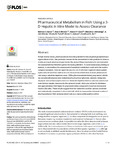Pharmaceutical Metabolism in Fish: Using a 3-D Hepatic In Vitro Model to Assess Clearance

Date
2017-01-03Author
Subject
Metadata
Show full item recordAbstract
At high internal doses, pharmaceuticals have the potential for inducing biological/pharmacological effects in fish. One particular concern for the environment is their potential to bioaccumulate and reach pharmacological levels; the study of these implications for environmental risk assessment has therefore gained increasing attention. To avoid unnecessary testing on animals, in vitro methods for assessment of xenobiotic metabolism could aid in the ecotoxicological evaluation. Here we report the use of a 3-D in vitro liver organoid culture system (spheroids) derived from rainbow trout to measure the metabolism of seven pharmaceuticals using a substrate depletion assay. Of the pharmaceuticals tested, propranolol, diclofenac and phenylbutazone were metabolised by trout liver spheroids; atenolol, metoprolol, diazepam and carbamazepine were not. Substrate depletion kinetics data was used to estimate intrinsic hepatic clearance by this spheroid model, which was similar for diclofenac and approximately 5 fold higher for propranolol when compared to trout liver microsomal fraction (S9) data. These results suggest that liver spheroids could be used as a relevant and metabolically competent in vitro model with which to measure the biotransformation of pharmaceuticals in fish; and propranolol acts as a reproducible positive control.
Collections
Publisher
Place of Publication
Journal
Volume
Issue
Pagination
Number
Recommended, similar items
The following license files are associated with this item:

